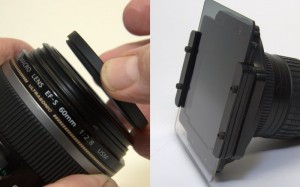UV Filter
Useful at high altitude to reduce the effect of the more intense UV light also used as a protective element when fitted to the lens to prevent damage to the front of the lens.
Some people use them some don’t as the filter invariable will influence the light passing through the lens some photographers won’t use one as they are not prepared to suffer the loss in image quality, others including myself use one to protect the lens as I feel any loss in image quality I may get (bearing in mind my lenses are not the top of the range) is outweighed by the potential to damage the lens when out and about. Its a matter of personal choice.
Neutral Density Filter (ND) and graduated neutral density filters (ND GRAD)
These filters reduce the amount of light entering the lens and should do so hopefully without affecting the colours, they came in a variety of strengths giving the photographer more choice as to what shutter speed and aperture is used and enable long exposures to be made in relatively bright light.
Neutral density graduated filters also come in a range of strengths and perform the same task the filter is normally dark at one end and gradually changing to clear at the other, very useful on a landscape with a bright sky and darker ground which would be difficult to photograph without losing the detail in the sky or ground by helping to balance the exposure by allowing the darker part of the scene to receive all the light and blocking some from the brightest part of the scene.
Polarizing filter CPL and PL
A polarizing filter helps to eliminate or reduce reflections from water or a surface or to enhance them, they are also useful to enhance or accentuate colours and they also help to reduce the effect of UV rays.
How and where do you fit filters?
On the front of a lens there is normally a couple of mountings a bayonet mount for the fitting of a lens hood and a screw thread to enable filters to be attached, Different lenses have different thread sizes, so if you have several lenses with different size filter mount threads you would need to buy a set of filters to suit each one.
Filter Systems
The simplest filter to use are the screw in type as you buy the filter and screw it straight onto the front of the lens but the flexibility is not great, to get round this various companies have produced filter systems, these filter systems invariably use square filters produced from squares of plastic or glass, they consist of various components.
A filter holder a frame with slots to allow the mounting of one or more filters in various combinations.
An adaptor plate generally would be fitted to each lens and the filter holder can then be moved from lens to lens.
A larger filter holder will enable the use of larger size filters essential when using Ultra wide lenses so the holder doesn’t impinge on the image.
Useful Links
